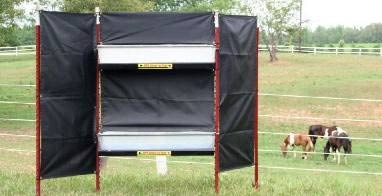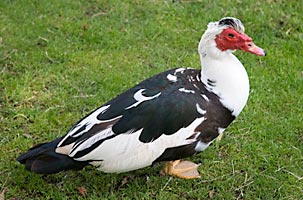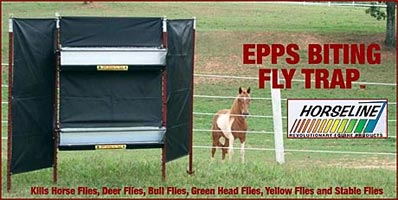Environmentally Friendly Ways to Control Flies
 |
The battle against flies is constant, but there are ways to reduce the numbers of these costly pests without pesticides and toxic chemicals.
by Heather Thomas and Epps Biting Fly Trap by Horse Line Products Inc.
Fly control tactics have changed a lot in the past several decades. After the advent of pesticides, the emphasis was on spraying the premises or use of chemicals on the animals themselves (pour on products, back rubbers, insecticide ear tags, etc.) but now we realize some flies are developing resistance to these chemicals, and we’ve also become more concerned with the environment. Use of pesticides can be harmful to beneficial insects as well as the ones we are trying to control.
Controlling Flies That Breed In Manure And Organic Matter
In livestock operations, one of the biggest problems is filth flies that breed in rotting organic matter such as old bedding/manure, wasted hay, etc. Bill Clymer, PhD (entomologist at Amarillo, Texas and Senior Consultant for Spalding Laboratories designing fly control programs) says stable flies are about the size of a house fly but a very aggressive biter, usually feeding on the legs and lower parts of the body. Cattle being attacked by large numbers of stable flies are restless and don’t eat well, often grouping together tightly to try to avoid these flies.
Stable flies don’t breed in straight cow manure like they will in horse manure. They prefer any kind of decaying matter that’s high in plant waste such as wet hay or old bedding. Texas A&M did a study 2 years ago and found that if you don’t clean up the areas where you feed big bales in feeders, this makes ideal breeding ground for stable flies, says Clymer. The researchers estimated that the area around one big round feeder would produce more than a million stable flies.
In the spring, one of the first things we do when it starts warming up is move the feeders and spread out the wasted hay with a front end loader, so it will dry out, or put it in a big pile so it will start heating and be too hot for fly reproduction. Sanitation, cleaning up any organic matter that could serve as breeding sites, can greatly reduce flies.
Find the source of fly breeding and deal with it, if possible. Clean up in the spring, and using a biological control like predator wasps can keep fly populations from building up by summer.
The tiny parasitic wasps are sold commercially, and lay their eggs in manure and rotting organic material. Their hatching larvae feed on fly larvae and pupae in the manure. The wasps can be ordered from several different companies, and put out early in the fly season before the fly population becomes large, with more wasps put out periodically through the summer.
If you can keep flies from getting ahead of you in the spring, you may not have to do as much to control them during the hottest part of summer. I’ve had the best results in fly control by using sanitation coupled with parasitic wasps. This won’t have any effect on deer flies or horse flies (since they don’t breed in manure) but can greatly reduce the numbers of house flies, stable flies, he says.
Another biological control is use of Muscovy ducks, a breed of meat duck that spends its time on  land (rather than water) eating insects. Some small farmers claim that 4 or 5 ducks per cow virtually eliminates a fly problem. According to Dennis French, DVM (Louisiana State University), in research trials, Muscovy ducks removed adult house flies 30 times faster than fly traps, fly paper rolls or bait cards. Ducks in cages with 100 flies took only 0.6 hours to remove 90 percent of the flies compared to 15.3 hours for the most effective commercial bait devices. “In other studies, the ducks lived for 12 weeks in pens with calves, without injury or any additional feed for the ducks. They ate about 25 house flies per 15 minute observation period when fly populations were low to moderate,” says French.
land (rather than water) eating insects. Some small farmers claim that 4 or 5 ducks per cow virtually eliminates a fly problem. According to Dennis French, DVM (Louisiana State University), in research trials, Muscovy ducks removed adult house flies 30 times faster than fly traps, fly paper rolls or bait cards. Ducks in cages with 100 flies took only 0.6 hours to remove 90 percent of the flies compared to 15.3 hours for the most effective commercial bait devices. “In other studies, the ducks lived for 12 weeks in pens with calves, without injury or any additional feed for the ducks. They ate about 25 house flies per 15 minute observation period when fly populations were low to moderate,” says French.
Biological control of horn flies (that breed in fresh cattle manure) includes use of dung beetles. These beetles live in fresh manure and carry it away in small brood balls or tunnel underneath the manure pat and bury it. The beetles’ developing larvae consume the manure. Activity of the beetles disrupts the manure enough to eliminate or retard the development of fly larvae by about 90 percent. Native dung beetles are helpful (if they are not killed off by insecticides or deworming products that end up in the manure) but are not as efficient as some of the larger species that have been imported from Africa.
Fly Traps
There are a number of fly traps available today, and new ones being developed. Various types of traps have been created for different types of flies. Greg Johnson, entomologist at Montana State University, says that years ago he used panel traps for stable flies. You can catch a lot of them with one of these traps, made with flexible plastic and a sticky covering on each of the panels. Sunlight is reflected off the panels and it attracts the flies, he says.
Clymer says these traps were developed in Florida, looking at the type of light that attracts stable flies. Researchers used white plastic panels around the perimeter of a property, to catch flies that are migrating in from somewhere else. You don’t get all of them, but in the Florida study they got several hundred flies per day in these individual traps, says Clymer.
Don’t put any kind of fly trap that uses an odor or bait attractant by your back door. The traps attract flies and some of the flies may go right into the house when the door is open, says Clymer. You want the trap a ways from the house so the attracting odor will draw them away from your door and to the trap.
Dr. French says there are some relatively new horse fly/deer fly traps that are simple in design. One is a black ball that attracts the flies. They go up underneath a canopy to get to it, and when they decide this isn’t where they want to be they fly straight up and into a jar that captures them. A couple of my clients use these traps and report that they work quit well, says French.
Devices that kill flies on contact (such as the fly electrocuters) kill some flies, but not all types. Lee Townsend, PhD, Extension Entomologist at University of Kentucky, says house flies will go to these, but stable flies and horse flies typically do not.
Some of the mosquito magnets produce warmth and carbon dioxide and are attractive to a number of biting flies, but it’s hard to say how what percent of the fly population they kill, he says.
In large open areas without many sources of blood meals for mosquitoes and blood sucking flies, a trap might be more useful than in an area where there’s vegetation or buildings and a lot of competition for the flies’ attention, or other things that would block out what’s attractive about these traps. We’ve used some of these traps for mosquito studies and we do get other insects and flies caught in them, but you shouldn’t rely on these to solve a fly problem, says Townsend.
One of the most effective ways to control biting flies (especially horse flies and deer flies) is the  Epps Biting Fly Trap™, invented by a cattleman in Oklahoma, Alan Epps. Epps runs 250 cattle and came up with this novel trap after being frustrated by the failure of other methods to control biting flies, especially horse flies. In summer his steers were covered with flies, dripping blood from the bites, and developed big welts all over their bodies. He’d tried common methods of fly control, including insecticides on the cattle, but nothing worked very well or for very long. It’s especially difficult to control horse flies and deer flies because they breed in wet areas (where you can’t use pesticides because of concern for the environment) and their breeding sites may be miles away from your farm or ranch.
Epps Biting Fly Trap™, invented by a cattleman in Oklahoma, Alan Epps. Epps runs 250 cattle and came up with this novel trap after being frustrated by the failure of other methods to control biting flies, especially horse flies. In summer his steers were covered with flies, dripping blood from the bites, and developed big welts all over their bodies. He’d tried common methods of fly control, including insecticides on the cattle, but nothing worked very well or for very long. It’s especially difficult to control horse flies and deer flies because they breed in wet areas (where you can’t use pesticides because of concern for the environment) and their breeding sites may be miles away from your farm or ranch.
Epps tinkered with different things ideas for 3 years and researched the natural habits of biting flies, Flies are attracted to the shape and silhouette of an animal, so Epps made a framework of wood to attract them. The frame has a large contrasting surface area, utilizing a dark portion and transparent panels to simulate air space above an animal and under its belly—the areas flies normally circle before landing on the animal to bite. When flies hit the transparent sheets they ricochet into trays of water below, and drown.
A research project at Cornell University showed this trap worked 10 to 1 compared to any other trap they tried. They tested it for 3 years in upstate New York on dairy farms, looking at a non chemical approach versus use of pesticides, The problem with pesticides is that they only work short term and some insects are developing resistance.
The trap works best in an open area where flies can see it from a distance. When set up, it’s about 5 feet tall and 7 feet long. All you have to do is scoop out dead flies every other day or so with an aquarium net, add more water and soap if needed, and change the water about every 2 weeks. There’s no messy bait to handle, and it doesn’t matter what kind of dish soap you use.
If the trap is in a pasture or barnyard, you can put an electric wire around it so animals won’t rub or damage it.
Contact: Horse Line Products Inc.
1340 Jones Rd.
Henderson, TN 38340
Phone: 1-800-208-4846
Email: mark@horselineproducts.com
Website: horselineproducts.com